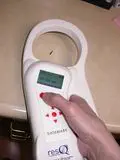“So, on those microchips, what kind of range do they have?” About three inches. When people don’t really understand what microchip identification is, they can have some unrealistic expectations.
 Look at this little thing: do you see any room for a power
Look at this little thing: do you see any room for a power
supply? I mean, I’ve heard of the “button battery”, but you’d have to have the “grain of millet” battery. The whole thing is no bigger than a grain of rice. There’s just no way you could track it from the black helicopters.
There are GPS tracking collars, but the units are as big as a deck of cards. It just wouldn’t be practical to implant them under the skin.
 The microchips used for animal identification aren’t big
The microchips used for animal identification aren’t big
enough to accommodate a power supply, so they can be easily injected through a needle. No sedation is required. If a dog will accept an injection with the smaller needles usually used for vaccinations, they usually don’t flinch (even though a 14-gauge needle looks big enough to scare superman – ask folks who have them inserted for dialysis treatments).
What you have, then, is an “identification tag” that cannot be lost, or seen, either, for that matter.
Since the microchip is invisible, I always recommend that the pet wear an I.D. tag. That way, when someone
finds your pet, they can just call you.
 If the tag is lost, or the pet winds up in a shelter, or
If the tag is lost, or the pet winds up in a shelter, or
there is some dispute about the ownership of the animal, the microchip is a great thing to have. Chips can be seen on an X-ray, but you have to use a scanning device to read the number and get the pet home again. The number can then be referenced with databases found on the internet, and then one contacts the owner.
The chips are registered first to the individual who purchases them from the company. Some chips require the pet-owner to register the chip at an additional fee. Some have the individual registration included in the price of the chip. In the first case, a veterinarian would keep a ledger and put you in touch with the pet-owner, if the owner had declined to spend the extra money for individual registration.
That’s the theory, at least. But things don’t always work out the way you think they might.
 Last week, one of our clients found a stray Beagle and brought it in to us because the animal control officer was on holiday for the MLK weekend. The dog looked a bit rough, no collar, no sign of identification. He had infections in both ears, and was wormy. I scanned him for a microchip, not really expecting to find one. Lo and behold, the scanner beeped to signal the finding of a microchip and there was the identification number.
Last week, one of our clients found a stray Beagle and brought it in to us because the animal control officer was on holiday for the MLK weekend. The dog looked a bit rough, no collar, no sign of identification. He had infections in both ears, and was wormy. I scanned him for a microchip, not really expecting to find one. Lo and behold, the scanner beeped to signal the finding of a microchip and there was the identification number.
Man, I was stoked. I always scan, and this time it paid off. This dog was going home to his folks… or not. When I checked the number, it was an “unregistered microchip”. We can handle that. The next thing is simply to call the manufacturers and see who bought the chip.
“Well, I’m a breeder, and I sold the dog to Joe Blow.” And Joe Blow sold him to John Doe because he wouldn’t hunt to suit him. And when we called John Doe, we found that he had sold the dog to Joe Doakes because he wouldn’t hunt to suit him. And Joe had sold him to Billy Bob Bubba and the dog wouldn’t hunt to suit him, either. He told us to put him to sleep, or find him a home.
He’s on the way to Beagle rescue now, and he will find a home, even if it’s in spite of his microchip rather than because of it. He may not hunt to suit anybody, but he’s friendly and happy, and will make a good friend.

